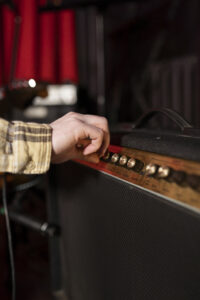Introduction
If you’ve just got your guitar amp, you’re going to want to know how to tweak all those knobs in order to get a great guitar tone. I remember when I got my first amp, I had no idea what they all meant. It took a lot of reading, asking questions and experimentation to figure it all out. Hopefully this guide will speed up your journey, so you can get a great guitar sound out of your amplifier.
Setting the Gain
The gain knob is your amplifier’s distortion control. It measures the amount of overdrive in your sound—the more gain, the more distorted your tone will be. Guitarists use this setting to create a clean sound, or one that’s slightly distorted but not too much so (think of Eric Clapton). Using a lower gain setting will produce a cleaner tone, while turning up the volume knob and dialing up some gain can give you a thicker, crunchier sound.
Depending on your amplifier, you’re going to want to try this on both the clean channel and the overdrive channel to see what difference this makes. Start with the gain at 0 then at 10. You now know the range of gain available to you. To find that sweet spot try setting to the midway point at 12 o’clock, then slowly adjusting lower for less gain or higher for more, until you find the right level for your style of playing.

Setting the Volume
The volume knob is used to control the amount of signal going into your amplifier. The higher you turn it up, the louder your signal will be. The lower you turn it down, the quieter your signal will be. Turning your volume knob all the way down is equal to having no guitar plugged into an amp!
Turning the volume up too high can cause feedback and turning the volume down too low can cause a weak sound or no sound at all (if there’s no power pushing through). Set the volume to suit the space that you are playing in. You don’t want to be too loud and annoy your neighbors, so if you’re playing at home, start low and gradually turn it up to a comfortable level.
Using your amp’s EQ settings is key to fine-tuning your tone.
EQ is short for equalization, and it’s a series of filters that allow you to adjust the tone of your guitar. It’s also used to adjust the frequency response of your amp. If you’re using an amp with two channels (clean, cr and overdrive), there will be two separate EQs: one for each channel.
In most amps, there are three bands: bass, mid and treble; however some amps have only two bands or one band that can be adjusted with three different frequencies.
Setting the Bass
The bass control on your amplifier controls the amount of low frequencies in your tone. The bass knob can be used to add or subtract bass from your tone, or it can be used to shape the overall amount of bass in your guitar sound. For example, if you want a lot of bottom-end thump but don’t want to sacrifice too much high end clarity, turning down the treble and keeping the middle at 12 o’clock (straight up) will give you plenty of midrange with increased low end punch. In contrast, turning up both treble and middle will keep everything clean while boosting both ends equally for a tighter sound that still has plenty of “punch” when played through an amp with plenty of power behind it (like something along lines like Fender Twin Reverb).
Setting the Mid
The Mid control is the most important control on your amplifier. It controls the tone of the guitar. It can make it sound brighter, darker and more or less boomy. The mid range controls how much fundamental you hear in your pick attack and how much overtones are added to this fundamental by adjusting its prominence in relation to other frequencies produced by your amp.
Midrange settings can vary from “bright” (more mids) to “dark” (less mids). Adjusting any of these settings will affect both your rhythm playing and lead work so be careful!
Setting the Treble
The treble is the brightness of your guitar. It can be set at a midpoint, OR it can be boosted to add more sparkle and presence to your tone. It can also be cut to remove harshness from your tone.
With all of the EQ knobs, try their full range as per what you did with the gain. Once you’ve established their range, set them to the 12 o’clock position and adjust each one in turn until you hit the point that you like the best.
Setting the Reverb
Reverb is a great way to add depth to your guitar tone, but it can also make things muddy. If you’ve ever heard a song that sounded like there was something wrong with the mix, or if you’ve ever felt like something in your own mixes isn’t quite right, this might be the cause. Reverb is an effect that sends a sound out into space and then brings it back into the mix.
Conclusion
Now you know what all the knobs do, keep tweaking, as it will take some time and practice to get those settings right. Write down your preferred settings and combinations on a piece of paper and keep it near or stick it to your amp. You could even try making small chalk marks next to the numbers to remind you of where it should be set. Once you’ve got your amp settings mastered try adding some effects pedals, see our guide here to get started.

Credit
‘https://www.freepik.com/photos/music-artist’ Music artist photo created by freepik – www.freepik.com

Pingback: A beginner’s guide to guitar amplifiers. | Guitar Jive